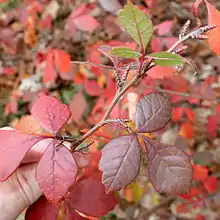Rhus aromatica
Rhus aromatica, the fragrant sumac,[1] is a deciduous shrub in the family Anacardiaceae native to North America. It is found in southern Canada (Alberta to Quebec) and nearly all of the lower 48 states except peninsular Florida.[2] It grows in upland open woods, fields, barrens, and rocky cliffs.
| Rhus aromatica | |
|---|---|
 | |
| Fragrant sumac | |
| Scientific classification | |
| Kingdom: | Plantae |
| Clade: | Tracheophytes |
| Clade: | Angiosperms |
| Clade: | Eudicots |
| Clade: | Rosids |
| Order: | Sapindales |
| Family: | Anacardiaceae |
| Genus: | Rhus |
| Species: | R. aromatica |
| Binomial name | |
| Rhus aromatica | |
Fragrant sumac is a woody plant that can grow to around 2 to 4 m (6.6 to 13.1 ft) tall with a rounded form. It produces yellow flowers in clusters in March or April before the leaves emerge, before anthesis.(1.) Pistillate (female) plants bear hairy red drupes in July or August that can last until the next March if not eaten by birds or small mammals.
The leaves and stems of fragrant sumac have a citrus fragrance when crushed, hence the species name. Leaves resemble those of its relative poison ivy, but fragrant sumac is not poisonous. It inhabits mostly uplands areas, while poison ivy has no odor and can inhabit various habitats. The leaves are alternate and trifoliate with the middle leaflet being the largest of the three. It develops a good autumn color like other sumacs of bright yellow to red to red-purple. Some are grown by large, diverse nurseries or by native-plant nurseries and are infrequently planted in landscapes in the Midwest and East. It grows in full deep shade to full sun and well-drained soils slightly acid to well alkaline with a pH range of about 6.0 to 8.5. It has a shallow, fibrous root system and is easily transplanted. Some of its branches can trail upon the ground and root and it can ground sucker to form a colony, depending on the site.[3]
While this species is not really well-known and used often by landscapers and homeowners, the cultivar 'Gro-low' is commonly planted as a high groundcover, and some are sold at most any nursery or garden center. However, buying this plant is done mostly by landscape architects and designers, (or by customers influenced by nursery personnel recommending it), who know the plant, while most homeowners do not know it and look instead for bushes or groundcovers with pretty flowers or evergreen foliage. 'Low-Gro' sumac grows about 2 ft high and easily spreads 6 to 8 ft around, developing good autumn color.
Conservation status in the United States
It is listed as of special concern and believed extirpated in Connecticut. However, this status applies only to native populations.[4] In Washington, Connecticut, and New Hampshire it is considered introduced.[2]
References
- "Rhus aromatica". Natural Resources Conservation Service PLANTS Database. USDA. Retrieved 21 October 2015.
- "Rhus aromatica". County-level distribution map from the North American Plant Atlas (NAPA). Biota of North America Program (BONAP). 2014. Retrieved 20 April 2019.
- Highshoe, Gary L. (1988). Native Trees, Shrubs, and Vines for Urban and Rural America. New York: Van Nostrand Reinhold. pp. 662–663. ISBN 9780471288794.
- "Connecticut's Endangered, Threatened and Special Concern Species 2015". State of Connecticut Department of Energy and Environmental Protection Bureau of Natural Resources. Retrieved 28 January 2018. (Note: This list is newer than the one used by plants.usda.gov and is more up-to-date.)